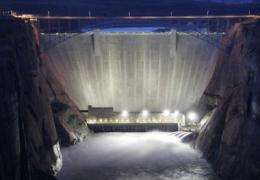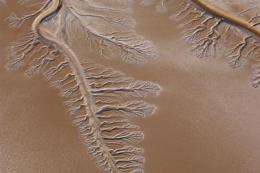A river ran through it: Research shows nature and humans leaving indelible mark on rivers

Rivers and streams supply the lifeblood of ecosystems across the globe, providing water for drinking and irrigation for humans as well as a wide array of life forms in rivers and streams from single-celled organisms all the way up to the fish humans eat. But humans and nature itself are making it tough on rivers to continue in their central role to support fish species, according to new research by a team of scientists including one from Arizona State University.
Globally, rivers and streams are being drained due to human use and climate change. These and other human impacts alter the natural variability of river flows. Some impacted rivers have dried and no longer run, while still others have actually seen increases in the variability of flows due to storm floods. The end result is that these two forces are conspiring to shorten food chains, particularly by eliminating top predators like many large-bodied fish.
"Floods and droughts shorten the food chain but they accomplish this in different ways," said John Sabo, an Arizona State University associate professor in the School of Life Sciences. Sabo is the lead author of the paper, "The Role of Discharge Variation in Scaling of Drainage Area and Food Chain Length in Rivers," which appeared Oct. 15, 2010, in Science Express, the online, early publication venue for the journal Science.
"High flows take out the middle men in the food web making fish (the top predator) feed lower in the food chain; droughts completely knock out the top predator. The end result in either case is a simpler food web, but the effects we see for low flows are more catastrophic for fish, and much more long lasting," said Sabo, who studies ecology, evolution and environmental sciences.
Sabo and his co-authors – Jacques Finlay, University of Minnesota, St. Paul; Theodore Kennedy, U.S. Geological Survey, Southwest Biological Science Center, Flagstaff, Ariz.; and David Post, Yale University, New Haven, Conn. – suggest that the fate of large bodied fishes should be more carefully factored into the management of water use, especially as growing human populations and climate change increasingly affect water availability.
The researchers studied the food webs that live in and depend on rivers for their survival. They studied 36 rivers and streams in the U.S. ranging in size from the Mississippi and Colorado Rivers, down to and their small tributaries. The rivers included in the study provide water for drinking to large cities like New York City, Minneapolis, Phoenix, Las Vegas and Los Angeles.
At the top of these food webs were large bodied fish, which appear the most vulnerable to variations in river flows. The researchers found that even though the mechanics were different, the end result of floods and droughts on the food webs were similar and the effects appear to be long lasting.
The study employed naturally occurring stable isotopes of the element nitrogen to measure how high top-predators were in the food chain. Nitrogen provides an indicator for how high a consumer is in the food chain because it bioaccumulates increasing by 3.4 parts per million with each link in the chain.
"Floods simplify the food web by taking out some of the intermediate players in it so that the big fish begin to eat lower on the food chain than they would if the food web were not exposed to high flows," Sabo said. "That makes them lower on the food chain themselves. Predators that eat lower on the food chain are having a dinner that has essentially missed a meal in itself. Imagine a lion eating grass, instead of eating gazelles that eat grass."
"With droughts, it's completely different, they just eliminate the top predator altogether because many fish just can't tolerate the low oxygen and high temperatures that follow when a stream starts drying out," said Sabo, who specializes in river and riparian ecosystems. "Even if it doesn't go completely dry, the conditions get so bad that the fish just can't handle it, and it takes them much longer to come back."

Sabo added that climate change is going to have a hand in frequency and intensity of the floods and droughts of coming years.
"Climate is giving us a new set of operating terms to work with," Sabo said. "We will experience overall drying and great weather variability, both of which will further shorten river food chains.
"There will be drying in some regions, particularly along the equators and increased flow in some rivers, primarily at higher latitudes," Sabo explained. "We will see more variability because there will be change in the seasonality of storms, ocean currents are changing and the way the ocean blows storms to us is going to be different. Drying and more variable flows are coming."
"In some places, like the Southwest U.S., we will get a double punch," he added. "As the streams dry, they also will become more variable in that as rain falls it will race over the parched ground, causing flooding"
Human toll
The human effect on rivers and streams and the food chain they support are closely tied to land use change, such as water diversion and regulation of flows due to dams.
Sabo outlined a classic scenario that humans face during drought years. As drought takes hold, the need for water for irrigation and other agricultural purposes increases and leads to a draw down of natural river flow. The effects downstream can be devastating. Natural drying through drought is not a human effect, but withdrawal of river water during a drought is, and it can have long-term consequences.
"We would not have guessed that infrequent drought would have had a big effect on the stream, but our results shows that it does," Sabo said. "River and stream water draw-down has a lasting effect."
"We found that some streams affected by drying 5 to 10 years ago, are still missing large-bodied fishes compared to same sized streams that never dried. That is the major difference," Sabo explained. "Our data show that food webs can recover sooner after a flood, in roughly a year, but it takes far longer to recover in the case of drying or drought."
The study hints that competing users of the river water – agricultural production and recreational uses like fishing – need to work out amenable use of rivers and streams that not only look to the immediate future, but also project long term effects of their use.
"The question becomes can you have fish and tomatoes on the same table," Sabo said. "They compete for the same resource and society depends on both – agriculture for grain, fruits, vegetables and river-caught fish for protein, particularly in the developing world."
"Humans may need to make some really hard decisions about how to allocate water so that we grow the right food but still leave enough in the rivers to sustain fish populations," he said. "Some river fish, like salmon in the U.S., are very important commercially."
Sabo added that scientists appear to be on the cusp of major advances in understanding how climate and human use of rivers affects biodiversity and global water security. This paper fits into this bigger picture because it suggests that some aspects of climate and human effects on biodiversity are mediated by the variability in freshwater supplies and thus, could have feedbacks on food security in regions of the world where freshwater fisheries are a significant source of protein for growing populations.
Provided by Arizona State University















